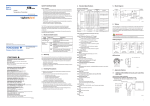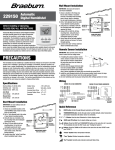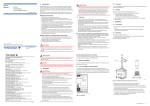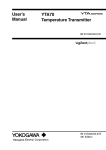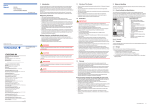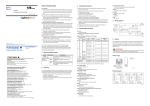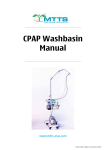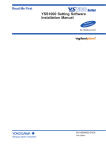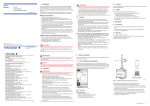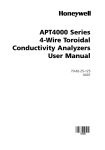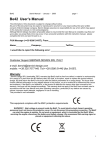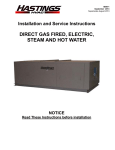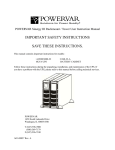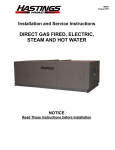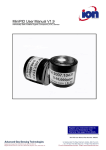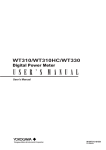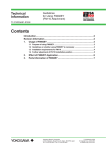Download User`s Manual
Transcript
Ex/I.S. installation: • For correct use and installation the manufacturer’s manual must be followed. When programming the Transmitter by PC and communication interface or a HART® terminal the intrinsically safe data shall be observed. • The designation galvanic isolation between the transducer input and the loop supply indicates signal isolation only. It shall not be interpreted as an Intrinsically Safe galvanic isolation like an isolating barrier. Therefore ordinary care in selecting barrier and grounding shall be considered. • The apparatus must be installed in an enclosure with an Ingress Protection of at least IP 20. • The terminals 1 and 2 of the equipment have to be electrically connected to a linear barrier located in the non hazardous area. • For Ex/I.S. data, see chapter 7. Approvals Options. Accuracy (see table below) The YTA70 is a head mount type of temperature transmitter that accepts thermocouple or RTD input and converts it to a 4 to 20 mA DC signal for transmission. The YTA70 specifies HART communication protocol for remote configuration. It is imperative that usres observe the instructions in this manual to ensure the protection and safety of operators. W3 W5 <RTD> Pt100 IEC751 Ni100 DIN43760 DC Voltage 1. Model and Suffix Codes *1: In T/C type B for output signal code J, the minimum range value can be set from 0. However, the accuracy between 0 to 400 is not specified. *2: Applicable for protocol revision of HART 7. 1st Edition 2. Warranty The warranty period of the instrument is as of condition shown when purchasing. Any trouble arising during the warranty period shall be replaced at free of charge. The following problems or troubles shall not be eligible of charge-exempt repair. • Caused by improper usage or storage of the customer which exceeds the specification requirements. • Caused by mishandling or modification. • Caused by fire, earthquake or other acts of God that are not directly a result of problems of the instrument. YOKOGAWA ELECTRIC CORPORATION Headquarters 2-9-32, Nakacho, Musashino-shi, Tokyo, 180-8750 JAPAN Phone : 81-422-52-5555 Branch Sales Offices Osaka, Nagoya, Hiroshima, Kurashiki, Fukuoka, Kitakyusyu 3. Handling Precautions YOKOGAWA CORPORATION OF AMERICA Head Office 12530 West Airport Blvd, Sugar Land, Texas 77478, USA Phone : 1-281-340-3800 Fax : 1-281-340-3838 Georgia Office 2 Dart Road, Newnan, Georgia 30265, USA Phone : 1-800-888-6400/ 1-770-253-7000 Fax : 1-770-254-0928 YOKOGAWA AMERICA DO SUL LTDA. Praca Acapulco, 31 - Santo Amaro, Sáo Paulo/SP, BRAZIL, CEP-04675-190 Phone : 55-11-5681-2400 Fax : 55-11-5681-4434 YOKOGAWA EUROPE B. V. Euroweg 2, 3825 HD Amersfoort, THE NETHERLANDS Phone : 31-88-4641000 Fax : 31-88-4641111 YOKOGAWA ELECTRIC CIS LTD. Grokholskiy per 13 Building 2, 4th Floor 129090, Moscow, RUSSIA Phone : 7-495-737-7868 Fax : 7-495-737-7869 YOKOGAWA CHINA CO., LTD. 3F Tower D Cartelo Crocodile Building, No.568 West Tianshan Road, Shanghai 200335, CHINA Phone : 86-21-62396262 Fax : 86-21-62387866 YOKOGAWA ELECTRIC KOREA CO., LTD. 14-1, Yangpyeongdong-4Ga, Yeongdeungpo-Gu, Seoul,150-866, KOREA Phone : 82-2-2628-6000 Fax : 82-2-2628-6400 YOKOGAWA ENGINEERING ASIA PTE. LTD. 5 Bedok South Road, Singapore 469270, SINGAPORE Phone : 65-6241-9933 Fax : 65-6241-2606 YOKOGAWA INDIA LTD. Plot No.96, Electronic City Complex, Hosur Road, Bangalore - 560 100, INDIA Phone : 91-80-4158-6000 Fax : 91-80-2852-1442 YOKOGAWA AUSTRALIA PTY. LTD. Tower A, 112-118 Talavera Road, Macquarie Park NSW 2113, AUSTRALIA Phone : 61-2-8870-1100 Fax : 61-2-8870-1111 (1) Read this manual throughly and carefully before handling the instruments. Observe the instructions. (2) Store the product in location that meets the following requirements. • No exposure to rain or water • No major mechanical vibration or shock • Humidity and Temperature limitations • Ordinary conditions(25°C, 65%) is preferable. Otherwise, as of specified in “Standard Specifications.” (3) Avoid corrosive atmosphere for storage and installation. (4) For safe installation of the transmitter in hazardous area, the following must be observed. The module must only be installed by qualified personnels who are familiar with the national and international laws, directives, and standards that apply to this area. (5) Yokogawa will not be liable for malfunctions or damage resulting from any modification made to this instrument by the customer. 360 90 90 90 180 360 360 90 90 135 90 0 to 2300 0 to 2300 32 to 4172 32 to 4172 200 200 360 360 -200 to 850 -328 to 1562 -60 to 250 -76 to 482 -800 to 800 [mV] 10 18 10 18 2.5 [mV] 0 to 7000 [Ω] 25 [Ω] ±0.1% of span or ±1.0°C ±0.1% of span or ±0.5°C 5. Block Diagram ±0.1% of span or ±1.0°C ±0.1% of span or ±0.5°C ±0.1% of span or ±1.0°C mV RTD.lin.R -Wire TC 4 3 2 + + mV - 1 6 5 4 mA Int. CJC - MUX PGA HART CPU Comm. A/D D/A 4 3 ±0.1% of span or ±0.1°C ±0.1% of span or ±0.2°C ±0.1% of span or ±0.01mV ±0.1% of span or ±0.1Ω Cold Junction Compensation Accuracy(For T/C only) ±1°C (±1.8°F) Ambient Temperature Effects (per 10°C Change) For E, J, K, L, N, T and U thermocouple inputs: ±0.05% of span or ±0.25°C, whichever is greater For R, S, B, Lr, W3 and W5 thermocouple inputs: ±0.05% of span or ±1°C, whichever is greater For Pt100 and Ni100 RTD inputs: ±0.05% of span or ±0.05°C, whichever is greater For DC voltage input: ±0.05% of span or ±5µV, whichever is greater For Resistance(ohm) input: ±0.05% of span or ±0.05Ω, whichever is greater Power Supply Effects ±0.005% of FS per Volt RFI Effects Tested per EN 61326, field intensity up to 10 V/m. EMC Conformity EN 61326 Maximum Zero Offset ±50% of the maximum temperature Input Signal Source Resistance (for T/C input) 10 MΩ, or 3 kΩ at power-off Input Lead Wire Resistance (for RTD input) 5 Ω per wire or lower (up to 50 Ω per wire is configurable with reduced measurement accuracy) Burnout High(NAMUR NE43 upscale) , Low(NAMUR NE43 downscale) or value within 3.5 to 20 mA Output Two wire 4 to 20 mA DC Response Time 1 to 60 sec programmable Ambient Temperature Limits (Option code may affect limit) –40 to 85°C (–40 to 185°F) Ambient Humidity Limits 0% to 95% RH (non-condensation) Supply Voltage 8 to 35 V DC 8 to 30 V DC for Intrinsically safe type 13.8 to 35 V DC for digital communication Load Resistance Limitation: 0 to (E–8)/0.0236 [Ω], where E is power supply voltage. supply + 8–35VDC 0_16 mA EEPROM 2 supply 4–20 mA A YTA70 F01E.ai 6. Wiring See wiring diagram. For output signal, use twisted pair or cables with performance equivalent to 600V vinyl insulate cable. For wiring in high or low temperature, use a wire or cable suitable for such temperature. Use cables and wires which meet atmospheric conditions. Take necessary measure to avoid corrosion or damage of cables and wires. IMPORTANT When mounting on a sensor head, do not overtighten the screws. n Wiring Diagram (+) 1 2 3 4 5 6 SUPPLY (–) (–) (+) T/C or DC milivolts 1 2 3 4 5 6 (+) (B) SUPPLY (–) (A) Two-wire RTD or ohm 1 2 3 4 5 6 (+) SUPPLY (–) (B) (B) (A) Three-wire RTD or ohm 1 2 3 4 5 6 (+) (B) (B) (A) SUPPLY (–) (A) Four-wire RTD or ohm F02E.ai n Dimensions Unit : mm (approx. inch) 33 (1.30) Ø6 ) (0.24 Ø 44 (1.73) IECEx intrinsically safe, FM intrinsically safe/ Nonincendive, and ATEX intrinsically safe approval combination 200 50 50 50 100 200 200 50 50 75 50 2 ATEX intrinsically safe approval /SS2 752 to 3308 -148 to 1832 -148 to 2192 -292 to 2502 -292 to 2372 -58 to 3200 -58 to 3200 -328 to 752 -148 to 1652 -328 to 1112 -328 to 1472 − IM 01C50C03-02EN /KS2 400 to 1820 -100 to 1000 -100 to 1200 -180 to 1372 -180 to 1300 -50 to 1760 -50 to 1760 -200 to 400 -100 to 900 -200 to 600 -200 to 800 Accuracy (value whichever is greater) + Optional Specifications 1st Edition: Jan. 2014 (YK) All Rights Reserved, Copyright © 2014, Yokogawa Electric Corporation Resistance °F 1 - J . . . . . . . . 4 to 20mA DC with digital communication (HART 5/HART 7 protocol) GOST 3044-84 ASTM °C 3 Output Signal Descriptions Temperature Transmitter DIN43710 Minimum span °C °F 4 .......... IEC584 Input ranges 3 Suffix code <T/C> B *1 E J K N R S T L U Lr *2 Standard − Model YTA70 Sensor type Isolation Input/output isolated to 1500 V AC. Mounting DIN form B head mounting Terminals M3 screws Weight 50 g (0.11 lb) + IM 01C50C03-02EN 4. Standard Specifications 5 YTA70 Temperature Transmitter SAFETY INSTRUCTIONS 6 User’s Manual 20.2 (0.80) F03E.ai YOKOGAWA MIDDLE EAST & AFRICA B.S.C.(C) P.O. Box 10070, Manama, Building 577, Road 2516, Busaiteen 225, Muharraq, BAHRAIN Phone : 973-17-358100 Fax : 973-17-336100 Oct. ’13 IM01C50C03-02EN P.1 7. Approvals Options 7.2 FM Intrinsically safe/Nonincendive model (/SS2) 7.3 IECEx Scheme Intrinsically safe model (/SS2) 7.1 ATEX Intrinsically safe model (/KS2, /SS2) Applicable Standard: Class 3600, Class 3610, Class 3611, Class 3810, ANSI/ISA-60079-0, and ANSI/ISA-60079-11 Installation diagram For safe installation of YTA70 the following must be observed. The module shall only be installed by qualified personnel who are familiar with the national and international laws, directives and standards that apply to this area. Year of manufacture can be taken from the first two digits in the serial number. For safe installation of YTA70-J/KS2 and YTA70-J/SS2 the following must be observed. The module shall only be installed by qualified personnel who are familiar with the national and international laws, directives and standards that apply to this area. Year of manufacture can be taken from the first two digits in the serial number. Applicable Standard: EN 60079-0: 2009, EN 60079-11: 2007, EN 60079-26: 2007, EN 61241-11: 2006 [ Installation diagram ] Hazardous Area Terminal: 3, 4, 5, 6 Uo: 9.6 VDC Io: 28 mA Po: 67 mW Lo: 35 mH Co: 3.5 μF 4 YTA70 2- 3 Terminal: 1 , 2 Vmax or Ui: 30 V Imax or Ii: 120 mA Pmax or Pi: 0.84 W Ci: 0 µF Li: 10 µH 1+ 6 1+ 5 Terminal 3,4,5,6 Vt or Uo: 9.6 V It or Io: 28 mA Pt or Po: 67.2 mW Ca or Co: 3.5 uF La or Lo: 35 mH Associated Apparatus or Barrier with entity Parameters: UM ≤ 250V Voc or Uo ≤ Vmax or Ui Isc or Io ≤ Imax or Ii Po ≤ Pi Ca or Co ≥ Ci + C cable La or Lo ≥ Li + L cable Certificate No.: IECEx KEM 10.0086 Applicable Standard: IEC 60079-0:2007-10, IEC 60079-11:2006, IEC 60079-26:2006, IEC 61241-11:2005 [ Installation diagram ] Hazardous Area Zone 0, 1, 2, 20, 21, 22 T4: -40 ≤ Ta ≤ 85°C T6: -40 ≤ Ta ≤ 45°C Terminal: 3, 4, 5, 6 Uo: 9.6 VDC Io: 28 mA Po: 67 mW Lo: 35 mH Co: 3.5 μF This device must not be connected to any associated apparatus which uses or generates more than 250 VRMS F05-1E.ai 5 The entity concept The Transmitter must be installed according to National Electrical Code (ANSINFPA 70) and shall be installed with the enclosure, mounting, and spacing segregation requirement of the ultimate application. 4 2- 3 YTA70 Terminal: 1, 2 Ui: 30 VDC Ii: 120 mA Pi: 0.84 W Li: 10 μH Ci: 1.0 nF Barrier F04E.ai Maximum Ambient Temperature for gas-proof For T4: 85°C, For T6: 60°C Maximum Surface Temperature for dust-proof For T4: T105°C (Ambient Temperature: –40 to 85°C) For T6: T85°C (Ambient Temperature: –40 to 60°C) Installation notes For installation in a potentially explosive gas atmosphere, the following instructions apply: The sensor circuit is not infallibly galvanic isolated from the supply output circuit. However, the galvanic isolation between the circuits is capable of withstanding a test voltage of 500Vac during 1 minute. The transmitter shall be mounted in an enclosure form B according to DIN43729 or equivalent that is providing a degree of protection of at least IP20 according to EN60529 that is suitable for the application and correctly installed. If the enclosure is made of aluminium, it must be installed such, that even in the event of rare incidents, ignition sources due to impact and friction, sparks are excluded. If the enclosure is made of non-metallic materials, electrostatic charging shall be avoided. For installation in a potentially explosive dust atmosphere, the following instructions apply: The transmitter shall be mounted in a metal enclosure form B according to DIN43729 or equivalent, that is providing a degree of protection of at least IP6X according to EN60529 that is suitable for the application and correctly installed. Cable entries and blanking elements shall be used that are suitable for the application and correctly installed. For an ambient temperature ≥60°C, heat resistant cables shall be used with a rating of at least 20 K above the ambient temperature. For installation in mines the following instructions apply: The transmitter shall be mounted in a metal enclosure that is providing a degree of protection of at least IP6X according to EN60529, and is suitable for the application and correctly installed. Cable entries and blanking elements shall be used that are suitable for the application and correctly installed. Equipment that is FM-approved for intrinsic safety may be connected to barriers based on the ENTITY CONCEPT. This concept permits interconnection of approved transmitters, meters and other devices in combinations which have not been specifically examined by FM, provided that the agency’s criteria are met. The combination is then intrinsically safe, if the entity concept is acceptable to the authority having jurisdiction over the installation. The entity concept criteria are as follows: The intrinsically safe devices, other than barriers, must not be a source of power. The maximum voltage Ui(VMAX) and current Ii(IMAX), and maximum power Pi(Pmax), which the device can receive and remain intrinsically safe, must be equal to or greater than the voltage (Uo or VOC or Vt) and current (Io or ISC or It) and the power Po which can be delivered by the barrier. The sum of the maximum unprotected capacitance (Ci) for each intrinsically device and the interconnecting wiring must be less than the capacitance (Ca) which can be safely connected to the barrier. The sum of the maximum unprotected inductance (Li) for each intrinsically device and the interconnecting wiring must be less than the inductance (La) which can be safely connected to the barrier. The entity parameters Uo,VOC or Vt and Io,ISC or It, and Ca and La for barriers are provided by the barrier manufacturer. [ Nonincendive ] Non-hazardous Location Hazardous (Classified) Location Class I,Division2, Groups, A,B,C,D Class I, Zone 2, IIC 6 Ambient temperature limits T4: -40 to +85 deg. Celcius T6: -40 to +60 deg. Celcius sensor T4: -40 ≤ Ta ≤ 85°C T6: -40 ≤ Ta ≤ 60°C Non-hazardous Area sensor Ambient temperature limits T4: -40 to +85 deg. Celcius T6: -40 to +60 deg. Celcius II 1 G Ex ia IIC T6 or T4 Ga II 1 D Ex ia IIIC Da I M 1 Ex ia I Ma Non-hazardous Location Hazardous (Classified) Location Class I,Division1, Groups, A,B,C,D Class I, Zone 0, IIC 6 ATEX Certificate: KEMA 10 ATEX0027 Zone 0, 1, 2, 20, 21, 22 [ Intrinsically safe ] 1+ Associated Apparatus or Barrier 2- Voc or Vt ≤ Vmax Ca ≥ Ci + C cable La ≥ Li + L cable 5 4 YTA70 3 Terminal: 1 , 2 Vmax: 35 V Ci: 0 μF Li: 10 µH This device must not be connected to any associated apparatus which uses or generates more than 250 VRMS 8. HART Communication 8.1 Connection and Requirements A standard HART communicator can be used for programming the YTA70. The HART communicator must be loaded with the appropriate DDL driver for YTA70. Minimum loop resistance is 250Ω. If the receiving equipment has a lower resistance, a serial resistor must be inserted to communicate with the HART communicator. Non-hazardous Area [Connection] Control room Relaying terminals 1+ 6 5 + − 4 2- 3 YTA70 Terminal: 1, 2 Ui: 30 VDC Ii: 120 mA Pi: 0.84 W Li: 10 μ H Ci: 1.0 nF Terminal board Distributor YTA70 Barrier HART communicator F06E.ai Installation notes For installation in a potentially explosive gas atmosphere, the following instructions apply: The sensor circuit is not infallibly galvanic isolated from the supply output circuit. However, the galvanic isolation between the circuits is capable of withstanding a test voltage of 500Vac during 1 minute. The transmitter shall be mounted in an enclosure form B according to DIN43729 or equivalent that is providing a degree of protection of at least IP20 according to EN60529 that is suitable for the application and correctly installed. If the enclosure is made of aluminium, it must be installed such, that even in the event of rare incidents, ignition sources due to impact and friction, sparks are excluded. If the enclosure is made of non-metallic materials, electrostatic charging shall be avoided. For installation in a potentially explosive dust atmosphere, the following instructions apply: The transmitter shall be mounted in a metal enclosure form B according to DIN43729 or equivalent, that is providing a degree of protection of at least IP6X according to EN60529 that is suitable for the application and correctly installed. Cable entries and blanking elements shall be used that are suitable for the application and correctly installed. For an ambient temperature ≥60°C, heat resistant cables shall be used with a rating of at least 20 K above the ambient temperature. For installation in mines the following instructions apply: The transmitter shall be mounted in a metal enclosure that is providing a degree of protection of at least IP6X according to EN60529, and is suitable for the application and correctly installed. Cable entries and blanking elements shall be used that are suitable for the application and correctly installed. HART communicator HART communicator F08E.ai [Communication requirement] 600 R= External load resistance R (Ω) 250 E-8 0.0236 Digital Communication range 8.0 13.8 21.8 35.0 Power supply voltage E (V DC) F09E.ai 8.2 Switching HART Protocol Revision HART protocol revision of the transmitter can be selectable from 5 or 7. The HART protocol revision is set and shipped as specified in the order. To change the HART protocol revision after shipment, follow the procedure shown below. Please note that selecting HART 5 will change the model code of YTA70-J to YTA70-E on the configuration tool. 1) Call up the parameter for protocol revision change. Device setup -> Detailed setup -> Device information -> Revision numbers -> Chng universal rev 2) Activate the “Chg universal rev” method. 3) Select OK for confirmation message screen twice. 4) Select a HART protocol revision 5 or 7. 5) Enter a write protect password. The default password is “********”, eight asterisks. 6) The device will automatically restarts with a new HART protocol revision. Restart the HART configuration tool for parameter settings. 7.4 Name Plate [/KS2] [/SS2] F07E.ai F05-2E.ai IM01C50C03-02EN P. 2 8.3 Parameters YTA70 HART 7 DD Menu Tree Device setup YTA70 HART 7 DTM Menu Tree Device Configuration Configure/Setup Basic setup Tag Long Tag Range values Range configuration PV unit PV LRV PV URV PV LSL PV USL PV min span Sensor setup Snsr s/n Detailed setup Sensors Process sensor Review Snsr config Snsr type Snsr wire Snsr unit Snsr cable resist Snsr damping Snsr error detection Broken sensor Shorted sensor Snsr Snsr limit status Snsr data quality Snsr probe break detect Sensor setup El/CJC Snsr error detection Signal condition Output condition PV % rnge PV LRV PV URV Apply values PV LSL PV USL PV min span Analog output El/CJC El/CJC limit status El/CJC data Quality El/CJC probe break detect El/CJC config El/CJC trim El/CJC info HART output Device information Manufacturer Tag Long Tag Descriptor Message Date Write protect (Write enable) New password Revision numbers Max dev vars Device profile Diagnostics Device Diagnostics Diag/Service Status Loop test Calibration Simulate Dev var logging Trend Num trends support Current date Current time Control Dev var code Sample interval Date latest result Time latest result Result Device reset Process Variable Process Variables Process variables Dynamic variables Sensor errors ADC errors Misc. errors Cfg chng count Reset cfg chng flag Ext device status Poll addr Loop current mode Num req preams Num resp preams Set real-time clock Dyn var assignment Burst condition Event notification Universal rev Fld dev rev Software rev Hardware rev Final asmbly num Dev id Dev ser nr Chng universal rev Dynamic variables PV PV % rnge Loop current SV TV QV Dyn var status Dyn var assign Time stamp Loop current PV LRV PV URV Snsr config Snsr type Snsr wire Snsr unit Snsr cable resist Cable resist measurement Snsr damping Snsr s/n Snsr LSL Snsr USL Snsr probe conn Snsr temp standard Snsr min span Snsr trim Snsr trim reset Snsr zero trim Snsr L trim Snsr U trim Snsr trim support Snsr min L trim Snsr max L trim Snsr min U trim Snsr max U trim Snsr min diff trim Diag/Service Status Loop test Calibration Simulate Shorted snsr value NAMUR down NAMUR up Total burst msgs Burst message 1 Burst message 2 Burst message 3 Num events support Notif control Event mask Retry time Max update time Debounce interval Knowledge Broken snsr value NAMUR down NAMUR up Basic setup Burst mode Burst command Burst dev var Burst trigger mode Burst trigger level Burst units Update period Max update period Classification Sensors Review Event status First unack evt tgr Error detection Signal condition Output condition Online Menu 1.Device setup 2.PV 3.Electr 4.Snsr1 5.PV AO 6.PV %rnge 6.Reset max/min (Basic Setup) 3.Basic Setup PV % rnge PV LRV PV URV Apply values PV LSL PV USL PV min span Analog output HART output Manufacturer Tag Long Tag Descriptor Message Date Write protect Write enable New password Revision numbers Max dev vars Device profile 3.Output condition 5.Review Event notification Universal rev Fld dev rev Software rev Hardware rev Final asmbly num Dev id Dev ser nr Chng universal rev 4.Device information 1.Sensor errors 2.ADC errors 3.Misc. errors (Calibration) (Range values) 1.PV LRV 2.PV URV 3.PV unit 4.LSL 5.USL 1.Range values 2.D/A trim 3.Scaled D/A trim 4.Override D/A trim 1.Write protect 2.New password (Range values) 1.PV LRV 2.PV URV 3.PV unit 4.LSL 5.USL (Sensors) 1.Process sensor (Cable resistance) 1.Enter value 2.Measure value (Process sensor) 5.Sensor info (Analog output) 1.PV AO 2.Electr 2.Output rnge (Signal condition) 1.PV LRV 2.PV URV 3.PV unit 3.Sensor error 4.PV % rnge values 5.PV Damp 4.Loop test 5.Scaled (Output condition) D/A trim 6.D/A trim 1.Analog 7.Override output D/A trim 2.HART output (Sensor setup) 1.Sensor config 2.Error detection 3.Cable resistance 4.Snsr s/n 1.PV 2.Snsr1 3.PV unit 4.Sensor setup 1.USL 2.LSL 3.Min span (Output range) 1.AO 0% 2.AO 100% 3.AO lo lim 4.AO up lim (Sensor error values) 1.Broken sensor 2.Shorted sensor (Broken/shorted sensor) 1.Br(Sh) sensor 2.NAMUR down 3.NAMUR up (HART output) 1.Poll addr 2.Num req preams 3.Num resp preams F12E.ai Device Variables Mapping (HART 7) There are two device variables available. 1) Sensor 2) Electronics/CJC (El/CJC) No test performed broken sensor shorted sensor broken and shorted sensor Poll addr Loop current mode Num req preams Num resp preams Set real-rime clock Dyn var assignment Burst condition 1.Sensors 2.Signal condition El/CJC El/CJC limit status El/CJC data Quality El/CJC probe break detect El/CJC config El/CJC trim El/CJC Info. Loop current Loop current 0% Loop current 100% Loop current lower limit Loop current upper limit Set limit = NAMUR Loop test D/A trim Override D/A trim Broken sensor Shorted sensor 1.Tag 2.Range values 3.Sensor config 4.PV Damp 5.Snsr s/n (Detailed setup) 4.Detailed Setup Snsr value Snsr limit status Snsr data quality Snsr probe break detect Snsr config Snsr input trim Snsr info. F10E.ai Device information 5.Read max/min log Range configuration PV unit PV LRV PV URV PV LSL PV USL PV min span Process sensor 2.Loop test 4.Write Protection Enable dev var simultation Disable dev var simultation Snsr config Snsr type Snsr wire Snsr unit Snsr damping 1.Status 3.Calibration Apply values D/A trim Override D/A trim El/CJC Read dev var max/min log Reset dev var max/min log Snsr El/CJC Dev var status Time stamp Sensor errors ADC errors Misc. errors Cfg chng count Reset cfg chng flag Ext device status Num trends support Current date Current time Control Dev var code Sample interval Date latest result Time latest result Result Sensor s/n Apply values D/A trim Clear D/A trim PV PV % rnge Loop current SV TV QV Dyn var status Dyn var assign Time stamp (Diag/Service) 2.Diag/ Service Trend Tag Long Tag Range values (Device setup) (Process Variables) 1.PV 1.Process 2.Electr Variable 3.Snsr1 4.PV AO 5.PV % rnge (Status) Sensor data quality Sensor limit status El/CJC data quality El/CJC limit status Dev var logging Sensor config Detailed setup YTA70 HART 5 DD Menu Tree Read dev var max/min log Reset dev var max/min log Master reset Loop current Loop cur 0% Loop cur 100% Loop cur lower limit Loop cur upper limit Set limit = NAMUR Loop test D/A trim Clear D/A trim Broken sensor Shorted sensor Sensor El/CJC Dev var status Time stamp PV Snsr input trim Snsr info. Process variables PV Sensor Mapping SV TV Electronics/CJC QV F13E.ai Burst Parameters (HART 7) Broken snsr value NAMUR down NAMUR up Shorted sensor value NAMUR down NAMUR up Burst mode Burst command Burst dev var Burst trigger mode Burst trigger level Burst units Update period Max update period Classification Total burst msgs Burst message 1 Burst message 2 Burst message 3 Num events support Event notif control Event mask Event notif retry time Max update time Event debounce interval Knowledge Event status Time first unack event triggered F11E.ai Command Parameter PV Temperature value assigned to PV % range/Loop current Process variables/ Loop current Process vars/% range/Loop current with status Process vars/% range/Loop Current Self diagnosis information Burst Command Cmd1: PV Burst Msg Trigger Mode Continuous Window Rising Falling On-change Cmd2: % range/ Continuous Window Current Rising Falling On-change Cmd3: Dyanamic Continuous Window variables/Current Rising Falling On-change Cmd9: Device Continuous variables with status Window Rising Falling On-change Cmd33: Device Continuous Window variables Rising Falling On-change Cmd48: Additional Continuous device status Burst Trigger Source Burst Trigger Units PV Depend on PV assignment % range % PV Depend on PV assignment Sensor, El/CJC, PV, SV, TV, QV(*1) Depend on burst trigger source Sensor, El/CJC, PV, SV, TV, QV(*1) Depend on burst trigger source - - (*1)Loop current and % range are selectable from menu but not available. IM01C50C03-02EN P. 3 Parameters List Item Process variables Process variable Dynamic variable Output value PV Log Signal Condition Range value Range Limit Unit Damping Sensor Setup Sensor config Cable resistance Minimum span limit Sensor errors Output Condition Descriptions 7 <5> Measured variables in engineering unit - El/CJC <Electr> 7 <5> Terminal temperature - Dev var status 7 Display data quality and limit status of Snsr and El/CJC - PV/SV/TV/QV 7 Display dynamic variables - Dyn var status 7 Display data quality and limit status of PV/SV/TV/QV - Dyn var assign 7 Setting an assignment for PV/SV/TV/QV PV=Sensor, SV=El/CJC, TV=QV=None Calibration Parameter name Analog output trim Protocol revision Descriptions Initial setting D/A trim 7, 5 Allows the calibration of a selected analog output with an external reference at the operating endpoint - Clear D/A trim <Override D/A trim> 7 <5> Overrides any previous D/A trimming by restoring factory calibration values - Scaled D/A trim 5 Allows the calibration of the analog output with the external reference which is scaled at 0 to 100% Snsr trim 7 Trimming - Snsr zero trim 7 Zeroing - Snsr trim reset 7 Reset sensor trim for factory setting - Snsr L trim 7 Display lower point of sensor trim 200.0°C Snsr U trim 7 Display upper point of sensor trim 850.0°C Time stamp Time stamp 7 date and the time information which the transmitter maintains from the time of the power on 1900/1/1 0:00 Polling address Poll addr 7 Display and setting for multidrop (0 to 63) 0 Loop current mode 7 Loop current setting at multidrop Off Num req preams 7 Number of requested preambles 5 Num resp preams 7 Number of response preambles 5 Sensor trim Loop current <PV AO> 7 <5> Output value in mA - PV % rnge 7, 5 Output value with respect to the range in % - Read max/min log 5 Reads the maximum/minimum PV stored in the memory Reset max/min 5 Clears the PV maximum/minimum log and restart logging Range configuration 7 Range setting for PV LRV/PV URV - PV LRV/PV URV 7, 5 Lower/upper range value to defines the 0%/100% value of the measurement 0°C/150°C Apply values 7 Rerange by actual input - Snsr LSL/USL 7 Maximum/minimum values for range setting - El/CJC LSL/USL 7 Maximum/minimum values for El/CJC range -40°C, 135°C PV LSL/PV USL <LSL/USL> 7 <5> Shows the max./min. usable value for upper/lower range value - Set real-time clock Set real-time clock 7 Setting for date and time 1900/1/1 0:00 Snsr unit 7 Unit of sensor °C Burst mode Total burst msgs 7 The number of burst mode functions 3 El/CJC unit 7 Unit of El/CJC °C Burst mode 7 Setting for burst mode Off PV unit 7, 5 Unit of PV °C Burst command 7 Setting for burst command cmd1 Snsr damping <PV Damp> 7 <5> Damping time constant in seconds: 0.4 to 60.0s 0.4s Burst dev var 7 Setting for device variable of cmd9 or cmd33 First slot: DV0, the rest not used El/CJC damping 7 Damping time constant in seconds: 0.4 to 60.0s 0.4s Burst trigger mode 7 Snsr config 7 Sensor type and related settings. - Burst trigger mode selection from “Continuous”, “Window”, “Rising”, “Falling”, or “On Continuous change” Snsr type 7, 5 Sensor type and related settings. [When T/C or millivolts is selected] Always select “single” for a measurement type. [When RTD or ohm is selected] Always select 2-, 3- or 4-wire but others for the number of sensor wires. Pt100, 3-wire, °C *1 Burst trigger level 7 Setting for burst trigger level 0°C Burst units 7 Setting for unit of burst trigger level °C Update period 7 Update period for burst message 8s Max update period 7 Maximum update period for burst message 60s Num events support 7 Maximum number of event support 1 Notif control 7 Enable event notification on token-passing data link layer Off Event mask 7 Even masking Off Retry time 7 Event notification retry time 8s Max update time 7 Maximum update time for event notification 60s Debounce interval 7 Debounce Interval to detect an event 8s Event status 7 Display event status - First unack evt tgr 7 Display event time - Manufacturer 7, 5 Manufacturer identification code YOKOGAWA Model 7, 5 Model name YTA70-J Tag 7, 5 Tag number, up to 8 alphanumerical characters - Long Tag 7, 5 Tag number, up to 32 alphanumerical characters. - Descriptor 7, 5 Text which can be used by user in any way. Up to 16 alphanumerical characters - Message 7, 5 Text which can be used by user in any way. Up to 32 alphanumerical characters - Snsr wire 7 Display the number of sensor 3-wire Snsr El/CJC type 7 Display Internal CJC or Fixed CJC Internal sensor Snsr s/n 7 Setting of serial number for connected sensor 0 RTD factor 5 For RTD only. Leave it to “1.” 1 Cold junction compensation 5 For T/C only. Always leave it to “1.internal sensor.” Internal sensor Snsr cable resist 7 Display resistance of sensor cable 5.0Ω Cable resist measurement <Measure value> 7 <5> Actually measure the cable resistance of 2-wire RTD/ohm for compensation - Enter value 5 Enter new value of the RTD/ohm cable resistance for compensation 5.0Ω PV min span 7 Display PV minimum span 10°C Snsr min span <Min. span> 7 <5> Minimum settable span 10°C El/CJC min span 7 El/CJC minimum span 10°C Error detection 5 Type of sensor errors to be detected for burnout operation. (1)No test performed, (2) broken sensor broken sensor, (3)shorted sensor*3, or (4)broken & shorted*3 7 <5> Output value for 0%(100%) in mA. HART output Preambles Event notification Device information 4mA(20mA) Loop cur lower(upper) limit <AO lo(up) lim> 7 <5> Output lower(upper) limit in mA. NAMUR, or 3.8 to 23mA 3.8mA(20.5mA) Date 7, 5 Date information. MM/DD/YY. Not incremented. The date is updated whenever changing on figuration via configuration tool Factory calibration date Set limit = NAMUR 7 Setting for loop cur lower limit = 3.8mA, loop cur upper limit = 20.5mA - Write protect 7, 5 Enable write protect if correct password is entered*2 Not protected Loop test 7, 5 Change the output manually for testing the loop. 4mA, 20mA, or value within 3.5 to 23mA - Write enable 7 Disable write protect - New password 7, 5 Sets a new password for write protection, if correct password is entered - Revision numbers 7, 5 Revision information for software and hardware - Chng universal rev 7 HART protocol revision switch function As specified in order Input info 7, 5 List of input variables - Output info 7, 5 List of output variables - Device info 7, 5 See “Device information” in this table - 7 Setting for analog output value when sensor broken 23.0mA Shorted snsr value 7 Setting for analog output value when sensor shorted 3.6mA NAMUR down 7 Set analog output value to 3.5mA - NAMUR up 7 Set analog output value to 23mA - Sensor error values 5 Enter or select the output value when sensor error is detected. NAMUR upscale, NAMUR downscale, or value within 3.5 to 23mA NAMUR upscale [high]*1 Sensor errors 7, 5 Show error status related to a sensor. When any one of the errors turns “ON”, check the sensor and wiring ADC errors 7, 5 Show error status related to analog to digital conversion. When any one of the errors turns “ON”, restart the device. If error remains, replace the device Misc. errors 7, 5 Show error status related to a device. When any one of the errors turns “ON”, restart the device. If error remains, replace the device. Ext device status 7 This bit is set if any Device Variable is in an Alarm or Warning State Device Variable Alert (0x02) Cfg chng count 7 Configuration change counter - Reset cfg chng flag 7 Reset configuration change counter - Snsr error detection 7 Type of sensor errors to be detected for burnout operation broken and shorted sensor Snsr probe break detect 7 Display “Snsr probe break detect” when sensor error None Device variable logging Read dev var max/min log 7 Reads the maximum/minimum PV stored in the memory - Reset dev var max/min log 7 Clears the PV maximum/minimum log and restart logging - Data trending Trend 7 Data trending support function - Simulation Simulate 7 Execution of device variable simulation - Device reset Master reset 7 Software reset - Status Item Initial setting Broken snsr value Error detection Service Protocol revision Snsr <PV> Analog output range Loop cur 0%(100%) <AO 0%(100%)> Sensor error value Diagnostics Parameter name Review *1: Or as specified upon ordering. *2: The initial setting of password upon shipment is "********". *3: With T/C or milivolts for sensor type, the alarm is generated when the input signal drops down below 2.5 mV. Revision Record ● Manual No. : IM 01C50C03-02EN ● Title : YTA70 Temperature Transmitter Edition Date Page 1st Jan. 2014 — Revised item New Publication. IM01C50C03-02EN P. 4




